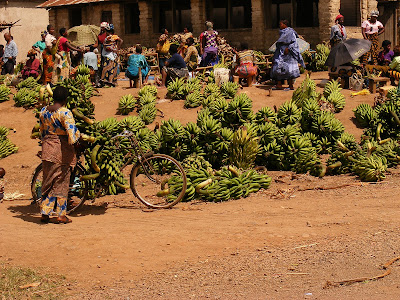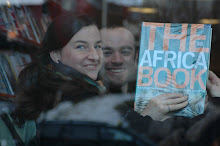Just as I was happy to escape the tourism industries of Kenya and Tanzania into Uganda I was equally relieved to escape the attitudes of many of the people of South-western Uganda and return to Tanzania, attitudes which ironically are probably due to their lack of communication with the outside world, be it Europe, the rest of Africa or even just Kampala. In any case, after crossing the border (again hassle-free!) and jumping in a Bukoba-bound minibus I suddenly felt ten-feet tall. Not just because I was the tallest person in the bus and my knees were squashed into seat in front but it also felt great to be back in Tanzania, despite not having held Arusha or Moshi in very high regard. Sure the people there were friendly, if a little insincere, but the cities themselves were very dull and grey and would be ignored by tourists were they not right next to the Serengeti, Ngorongoro crater and Mount Kilimanjaro!
Why did I feel so happy? Perhaps because I could see how friendly Tanzanians are to each other. Perhaps just because in Tanzania they only fill each seat once!
We arrived in the town of Bukoba just one hour before the thrice-weekly ferry was due to leave so we could only get 3rd class deck tickets. But we managed to buy two crews berths. We had a meal in the 1st class restaurant then retired to the lounge for a beer before bed, waking up to blue skies over beautiful Lake Victoria as we arrived in Mwanza. Sounds great doesn’t it? - I just haven’t mentioned the approx 3 million bananas on board (Ugandas biggest export) nor the 3 trillion insects they attracted, nor that 1st class is a relative term!!!!
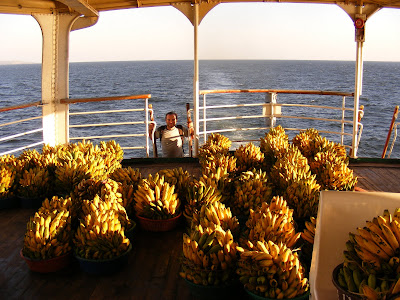
Mwanza is a modern, clean and spacious city with very friendly people. The lake side is home to some very posh houses perched on cliffs that have the appearance of some sort of Mediterranean resort. The air is pleasant and it is nice to wander around, even if there is little to actually do. The Indian traders selling everything from shampoo to fabrics kept us occupied and the street food was surprisingly tasty – especially the chicken and fish tikka with chips.
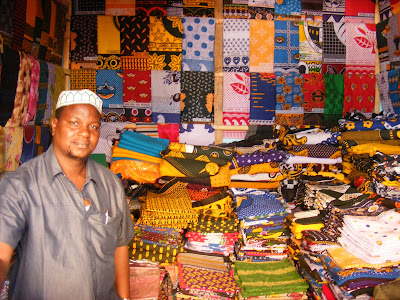
We bought bus tickets from Mwanza to Dar Es Salaam, a trip of over 1200km! Surprisingly, Tanzanian buses cannot travel at night, a safety law, so they leave at dawn and go like the clappers, covering the 1200km in 13 hours! It used to take 5 days but the road has been improved so it left us with a hole in our plans! The journey started alright but after about 300km our back axle buckled completely. No worries, jack it up, get a wrench and half the men on the bus and pull it back into place! And off we went, except we are leaking water by the gallon. After two stops of an hour each refilling it got to the point where a guy was sitting at the front of the bus pouring water in as we went along!! Finally at 3pm they gave up and we got in a new bus. This one did about 300km as well before we stopped. I had thought the brakes were bad and then I found out why. There were no brakes on the rear nearside, nothing. They stopped and put blocks under the bus (no jack) and installed new brake shoes and a drum in about 10 minutes, just wedging the wheel on and off using another wrench! We arrived in Dodoma, Tanzania’s quiet capital (and capital only in name), after dark but somehow were able to continue. We raced along, brakes squeaking, just 450km to go, until suddenly there was an almighty explosion and we skidded to a halt! Both tires on the rear offside had just exploded completely; I have never seen anything like it, there was nothing left!!!! Being the only person on board with a fully functioning torch I had to stand out in the middle of the road observing the quick change whilst we could hear the drums of a Masai village nearby and we did the final 450km slower, with a long rest stop in the middle, arriving safely in Dar at 6am, only 11 hours late! At least we saved on a nights accommodation costs!!!! That is why I am never again going on a long (over 4 month) trip anywhere where they don’t have tarmac, its damaging for body and mind - not just all the bumping but the heightened nerves and the extra beers you have to drink to calm down!!!!!!
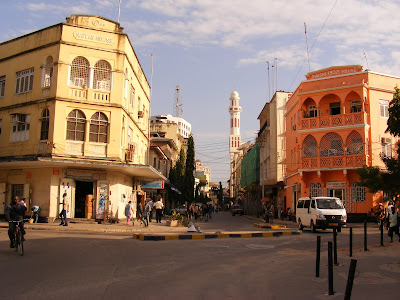
Dar Es Salaam is another nice city, so refreshing to find two in Tanzania after drab, ugly Arusha and Moshi! Again the Indian quarter was the highlight, the aroma of spice and curries and the colourful fabrics on display. Adjacent, the CBD is very clean and modern and the port area along the front looks like a picture in a book. We camped on Kipipeo beach, just 8km from the centre, but worlds away. Once you cross the Kigamboni ferry the city turns into a fishing village and fades away into nothing but a pristine sandy beach. It was not a bad place to wait for a week, both for our visa applications and for Stepan to visit on a one-night layover, where we were able to join him for an ‘all expenses paid’ night in the luxury 5*Hotel Kilimanajro Kempinsky, complete with outdoor swimming pool on the second floor terrace, rooftop bar with spectacular views and of course the famous Kempinsky breakfast buffet!
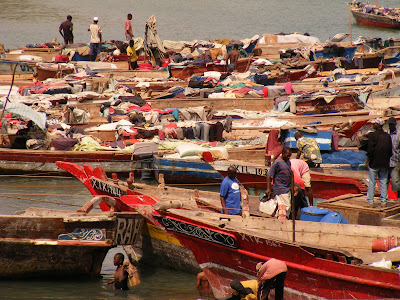
As we are just over half through this trip we viewed these two weeks as a half-time break – a week in Dar, a night in the Kempinsky and a week on Zanzibar. The spice island is only 1½ hours by fast ferry from Dar Es Salaam but of course foreign tourists pay a special fare of $35.
Zanzibar seems like a backpackers paradise but that ferry ticket should be your first clue that this is not the case. It is expensive, much more so than any tropical island in South East Asia let alone the beaches of Goa or Sinai. Nevertheless it is also probably much nicer than any of those options. The only negative point is probably the first one most people encounter when stepping off the ferry – the papasi. Papasi is Swahili for tick and is used to describe the ‘beach boys’ that hang around offering services to tourists – anything from ferry tickets to souvenirs to their bodies or illegal drugs. I can think of a word that rhymes with ‘tick’ that is a far more accurate description, although if you decline politely, after the third or fourth time they usually get the message and move on to someone else.

Apparently the Swahili spoken in Tanzania, especially that on the Zanzibar archipelago, is the most pure of all the various Swahili groups in Africa, not that I would know. It does sound somehow ‘smoother’ than that spoken in Kenya, where for instance it is diluted by the use of many English words interspersed within the sentences.
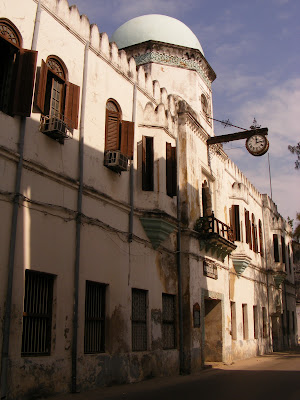
The main town on Zanzibar is Stone Town, a beautiful mix of winding alleys and coral buildings, interspersed with the odd relic of colonial charm such as the stately courthouse or the functional fort. Within the labyrinth is hidden a beautiful local market of colourful fruit and vegetables, the islands famous aromatic spices as well as stinky fish and smelly meat.
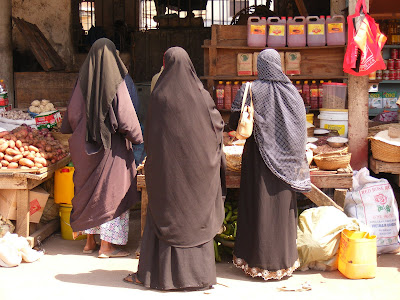
Forodhani Gardens is the place to sample all this local fare cooked to perfection. A fantastic night market where chefs grill skewers of tandoori octopus, prawns, lobster or squid as well as other fish such as tuna and shark and more mundane options such as chicken and beef skewers. There are bigger portions available for the hungry or greedy as well as tasty sides of coconut bread or the Zanzibar Pizza – a type of pancake within which they fry beef and vegetables with cheese and salad. To add to the experience the chefs are immaculately dressed in white with their hats standing out against the velvet black sky.
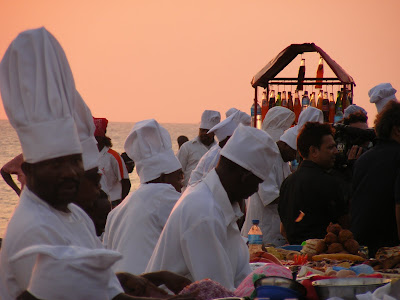
Forodhani Gardens is great but is only the start of the Swahili cuisine. Perhaps the most famous dish is the fish in coconut sauce (often flavoured with ginger) which is the signature of many Swahili chefs amongst their takes on curries, stews and other dishes. Spicy rice is another famous Swahili dish, although a more down-to-earth filler, pilau rice with potatoes and salad flavoured strongly with cinnamon and cardamom.

After all this eating it is almost obligatory to take the famous ‘spice tour’. It was actually very fun and interesting as we discovered the origins of all these spices and answered many questions – i.e. that black, white, green and red pepper all comes from the same corn but green and white cardamom come from two completely different plants. We also saw how they farm ginger and turmeric and where the colour of tandoori comes from, how cloves are picked and how cinnamon is just a tree bark that curls naturally in the sun. To stretch the tour out we also stopped for a ‘traditional meal’ before visiting an old bath-house, a former slave cave and the picturesque Mangapwani beach.
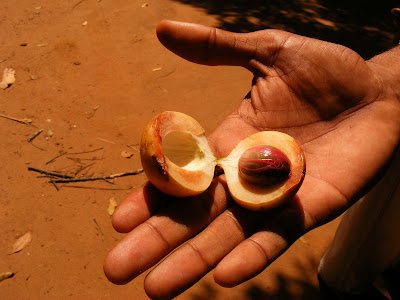
It was time to leave Stone Town and relocate to one of Zanzibar’s famous beaches. We chose Jambiani beach on the east coast, quiet and serene and away from the party atmosphere of the north. Picture the most kitsch tropical island postcard – swaying palms over white sand and turquoise water lapping at the shore. Every moment five different shades of blue. The extreme tide at Jambiani made the scene even more beautiful. For several hours each day during low tide it would be possible to walk over two miles out to see with the sea reaching knee-height. This left the most remarkable views both from afar and up close as small rock pools full of peculiar creatures formed around the white rocks. The location is everything and so, even though it was the cheapest on the beach, our chalet, not five steps from the beach cost around three times our normal amount. Our only disturbance during five days there were from the laid-back papasi and the more energetic groups of kids begging for money when they should have been in school!

We did manage to embark on a dolphin tour. Whilst not exactly ‘dolphin friendly’ it was exciting, we chased two pods of about 20 dolphins before jumping in to snorkel with them, they were so close we could almost reach out and touch them! We had four ‘swims’ with the dolphins before a short spell of snorkeling over the, disappointing, corals and finally a nice lunch of grilled fish, snorkeling always gives me the taste for fish!
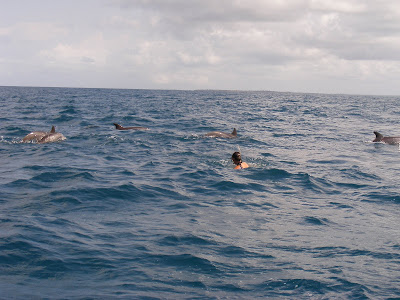
I wanted to hold on to the relaxed attitude that we had spent our five nights at Jambiani in but we didn’t even get back to Stone Town before it had started to crack, on the dala-dala (converted pick-up) a big African woman talked loudly incessantly without pausing even to breathe to anyone who would listen for the entire 2 hour journey! It cheered me up somewhat to return for a last taste of Forodhani Gardens before catching the slow overnight ferry back to Dar Es Salaam. At least this time we got something for the extra we had to pay - access to the first class seating, where we were able to lounge across three chairs whilst watching Gladiator on the overhead TV!
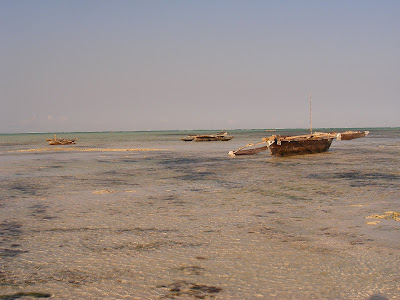
There was still time for a last insult before leaving Tanzania, Upon arrival in Dar we raced straight to the bus station and jumped on a bus to Mbeya, a town in the south close to the Malawi border. Three times someone tried to rip us off for the bus ticket and then, when we finally ascertained the correct price we did not receive our change, as it had been ‘dropped’. Then at the lunch stop the driver left four of us, Monika and I and two local men, sat eating our food. We ran down the road after them and told them to return and wait, only to find that our food had been cleared away!
The trip to Mbeya is around 700km so we arrived at dusk. We planned to stay at one of the lodges opposite the bus station but to our dismay found them all full. We tried another four or five places in town before finally finding a room. It was one of the more expensive in town but still there was no hot water and the shower flooded the whole room! We were just glad to get off the streets as Mbeya was probably the worst place we had visited in Africa. The town was full of drunks, junkies and prostitutes all wandering around the streets. We had never seen anything like it and it was nerve-wracking walking the streets with all our worldly possessions strapped to our back. The restaurant opposite the hotel reinforced this image of a run-down transient town with its American diner décor, straight out of a Coen brothers movie!
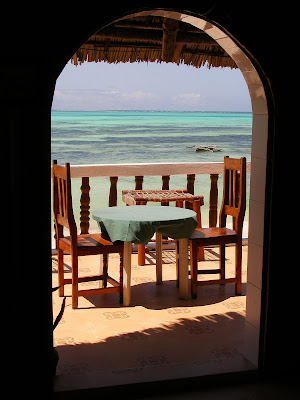
So, we are leaving the East Africa Community after two months and heading into the Southern Africa Development Community. The one thing I certainly won’t miss is the speed-bumps, something the governments of Kenya, Uganda and Tanzania have adopted with great gusto. There are many different styles but all are spine-wrenching. Take the road from Dar Es Salaam to Mbeya for instance, not a single hut in sight, just acres of burnt (by fire not sun) grass and baobab trees…. and speed-bumps. I also hope for a return to the more traditional style of African hut building with mud walls and thatched roofs. Since leaving Ethiopia the land has been dotted with ugly cement huts with shining corrugated iron roofs which I imagine must be less durable and more heat conducive as well as being incredibly unsightly.
